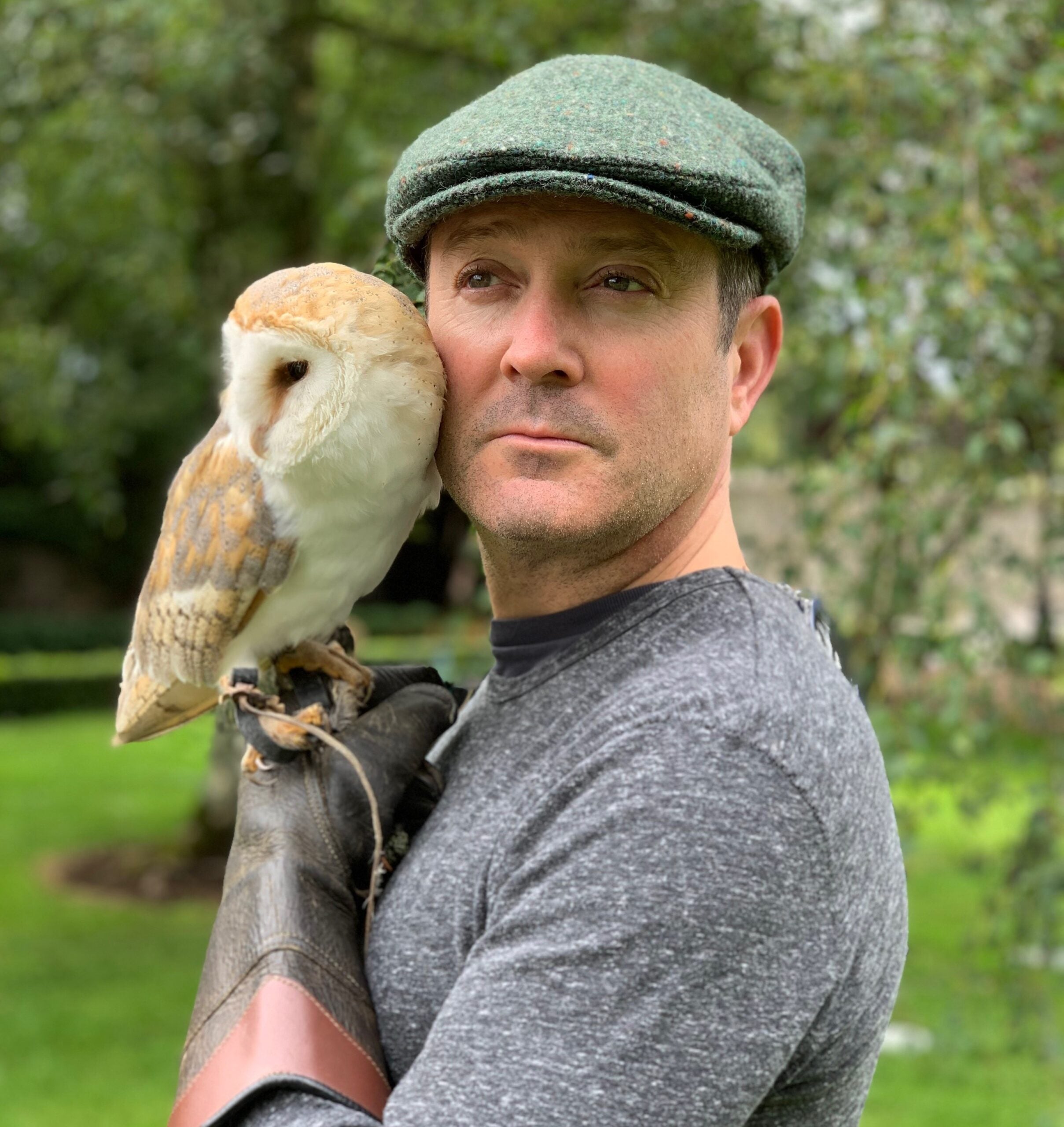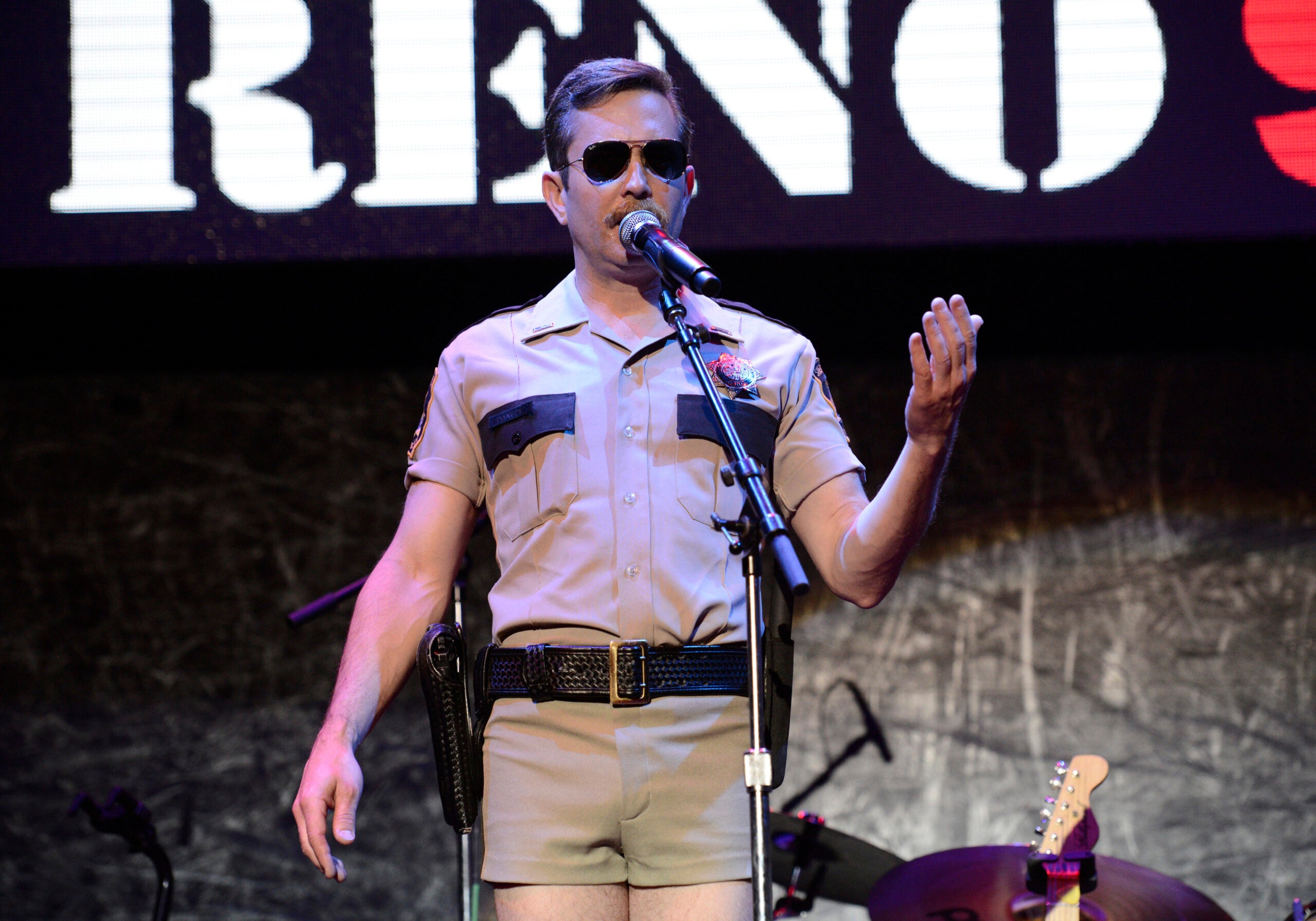Actor and comedian Thomas Lennon on the movie, ‘Reno 911!: The Hunt for QAnon.’ Also, author Chuck Klosterman revisits grunge, Tarantino, and Zima in ‘The Nineties.’ And Stephen Satterfield talks about the Netflix docu-series, ‘High on the Hog.’
Featured in this Show
-
Thomas Lennon on 'Reno 911!' and the team's 'Hunt for QAnon'
It’s been almost two decades since actor and comedian Thomas Lennon took on the role of Lt. Jim Dangle in the Comedy Central mockumentary, “Reno 911!”
A parody of the long-running copaganda series, “Cops,” “Reno 911!” ran from 2003-09 and again in 2020.
Well, Dangle returned this winter, reunited with his fellow “Reno 911!” cast members for the movie, “Reno 911!: The Hunt for QAnon.”
Lennon has appeared in many films and TV shows. And he’s co-written screenplays for the “Night at the Museum” movie franchise. As if that’s not enough, Lennon is the author of the middle-grade book series about a young detective named Ronan Boyle. He was also a member of the groundbreaking comedy troupe, “The State,” which had a show on MTV in the early 1990s.
“In 1988, we became a comedy group with a bunch of other people at (New York University), but from that very specific group, like a really weird amount of people stayed in comedy and are still like very busy people that you’ll see all the time,” Lennon told WPR’s “BETA.”
People like David Wain, Michael Showalter (director of “The Eyes of Tammy Faye“), Ken Marino (“Party Down“) and Joe Lo Truglio (“Brooklyn Nine-Nine“).
The last time the “Reno 911!” gang got together to make a movie was in 2007 for “Reno 911! Miami.”
‘Reno 911!’ and QAnon appeal
Executives at the Paramount Plus streaming service asked Lennon and the other actors if they would like to make another “Reno 911!” movie, and they agreed.
Then, the Paramount Plus people told Lennon and his crew that they would have to use the title, “Reno 911!: The Hunt for QAnon.”

Photo courtesy of Jenny Lennon “And we said, ‘Oh yeah, yeah, sure,’” he said.
The combination of the cast and the QAnon storyline was a perfect match, Lennon said. He’s pleased with ending in the movie, which reveals what QAnon is and where the crazy theories come from.
“I don’t want to spoil it, obviously, but there’s something about the level of incompetence of the ‘Reno 911!’ squad,” he said. “You could put us up against the Muppets. But I think that’s why it kind of works. There’s something just ever so slightly cartoonishly dumb about us that pairs well with something like that.”
The “Reno 911!” cast leaned in so far to the wackadoodle weirdness of QAnon that they almost fell over. And if a few cases, they did.
“We were never a bunch of badass cops,” Lennon said. “If we kicked down doors, we’d get hurt, and then we just fall down through the door. And there’s no one ever on the other side that we’re looking for, you know? Many police officers say that we were the most accurate cop show on TV. And they weren’t kidding when they said it to me.”
“We always joked among ourselves that somehow “Reno 911!” appeals to tons of recreational drug users and law enforcement in equal parts,” Lennon continued.
Besides slipping into Dangle’s trademark short shorts, Lennon also wore a showstopping QAnon romper.
“The idea is we would go undercover presenting ourselves as followers of Q, which led to some really amazing outfits,” he explained.
“So, I’ve got a patriotic QAnon outfit because Dangle’s always been an out gay character. I’ve got Pride Q flags on it. It’s really just wonderful. If they make a new action figure of me, the Pride QAnon ‘Don’t Tread on Me’ Romper just ticks a lot of weird boxes for folks, I think.”
And we here at BETA don’t think it’s a question of if they make an action figure of Dangle in his QAnon romper; it’s only a question of when.
On Ronan Boyle
When he’s not writing screenplays or acting, chances are pretty good that Lennon is working on his New York Times-best-selling Ronan Boyle series of middle-grade books — “Ronan Boyle and the Bridge of Riddles,” “Ronan Boyle and the Swamp of Certain Death” and “Ronan Boyle Into the Strangeplace.”
Lennon was inspired while visiting Ireland; he was in Turin Castle when someone showed him what a real Irish shillelagh looks like.
“I always pictured them as like sort of a cute little walking stick or something that would be in the Lucky Charms box,” he said. “It turns out it’s like a major heavy-duty weapon from when Irish people weren’t allowed to carry swords.”
So, this got the wheels of his brains turning, in large part because he’d always wanted to write a funny fantasy novel, along the lines of Douglas Adams’ “The Hitchhiker’s Guide to the Galaxy.”
Lennon’s books follow a 16-year-old who is recruited to serve on a special police task force in Ireland that deals with mythological Irish creatures like leprechauns, clurichauns, banshees and harpies.
“And it’s been enormously fun. I was never really a super strong reader until I got to things that made me laugh out loud,” he said. “And so I think my real intention with the Ronan Boyle books was to write books that young people would laugh out loud during. Like — not kind of — hopefully, you’ll laugh till you scream.”
Dreamworks is developing an animated film based on Lennon’s books.
-
Chuck Klosterman revisits grunge, Tarantino and Zima in 'The Nineties'
Remember the 1990s? Of course you do. Unless, of course, you were born in the year 2000 or later. And if that is indeed the case, we here at “BETA” should pat ourselves on the back for attracting such a young demographic.
New York Times’ bestselling author Chuck Klosterman really remembers the 1990s. He was in his 20s for most of that decade. In his new book, “The Nineties,” Klosterman explores everything you wanted to know about the ’90s, as well as some things that you might be afraid to remember, like Zima, and “Titanic” director James Cameron declaring himself “the king of the world” at the Academy Awards in 1998.
Klosterman told WPR’s “BETA” that the idea of selling out “complicated the lives of any young person in the ’90s with aspirations to do almost anything.”
“They had to factor in this specific way of understanding fame and success that consistently seemed to create a psychological obstacle toward just going out and being who you were,” he said. “I really feel like selling out is what the ’90s were about. Not the activity, but the fear of it.”
The rise of counterculture
In his book, Klosterman describes Nirvana’s 1991 album, “Nevermind,” as “the ideal mainstream version of counterculture ideology.”
“It wasn’t until the release of ‘Nevermind’ that we see the values we now associate with that period becoming the main values of youth culture. And the rippling effect in a nonmusical way that Nirvana had on society is pretty profound,” he explained.
Take, for instance, a 1993 commercial for a Subaru Impreza starring Jeremy Davies. Klosterman explained that Davies is trying to appeal to an audience of consumers who would normally buy Honda Civics.
In the commercial, Davies uses the analogy that the car is like punk rock. Davies mentions how rock-and-roll was “really boring and corporate,” and punk bands came in and shook things up.
“But what he’s really talking about is Nirvana because he can’t talk directly about Nirvana because they would never participate in a car commercial,” Klosterman said.
If Davies mentioned Nirvana, it might have discouraged buyers who thought he was making too much of an effort.
“So, he had to talk about Nirvana without talking about Nirvana,” Klosterman said. “And how do you do that? Well, it’s by suggesting that your product, whatever you’re trying to sell, contains the values alleged by Nirvana themselves, which was chiefly a real discomfort with any kind of conventional success, to the point where the idea of being super famous was not seen as the achievement of your career but really humiliating.”
Nirvana became paralyzed by fame when their underground, grunge style was cast as mainstream. Klosterman argues that one of the most important takeaways from Nirvana was not the songs they made but rather “how they felt about those songs being beloved.”

Photo courtesy of Joanna Ceciliani The rise of independent film
Klosterman describes the 1970s film industry as “a director’s medium.” That shifted to become more of a “producer’s medium” in the 1980s.
“Then in the early ’90s, there’s this explosion of independent film,” he said. “It wasn’t just that they were directing these films, they were writing them. They had almost complete control over everything.”
He points to Quentin Tarantino as “an example of someone who represents how the VCR (videocassette recorder) and videocassettes really changed filmmaking.”
VCRs really belonged to the ’80s, Klosterman explained. Before that, they were too expensive. But as they became cheaper and more accessible, video stores began to pop up, too.
“The video store allowed people who didn’t live in Los Angeles or New York to have access to a much wider library of film where they could create their own sort of personal specific film canon,” Klosterman said.
As he writes in “The Nineties”: “What was different about ‘Reservoir Dogs’ is that the movie was about the movie. It was not an attempt to make anyone rethink the notion of crime, or the complexity of masculine relationships, of the psychological consequences of witnessing torture; a viewer might well consider those concepts, but such considerations were ancillary.”
“A movie like ‘Reservoir Dogs’ is not about life, it is about the world of crime, as it had been expressed in other films,” Klosterman said.
Klosterman said that “The Nineties” is not a nostalgic book in the same way as his 2003 book, “Sex, Drugs, and Cocoa Puffs.” Also about the ’90s, that book takes a personal tour through Klosterman’s life, interests and his reality based on those interests.
Klosterman wouldn’t necessarily describe the “The Nineties” as academic, “but, like, it was a process that did not involve my feelings,” he said.
“I don’t think that I’ll look back on this book and be embarrassed by it in 20 years, because there are things from my early books that I know if I went back and reread, I would be embarrassed by,” he said.
When asked about something embarrassing in one of his earlier books, he mentioned his third book, “Killing Yourself to Live,” which was published in 2005.
“I was writing that book in kind of a diary form,” he recalled.
“So, there’s a few pages…where I literally explained what happened on the night I met my wife, written the day after it happened. I mean, I’m sure anybody listening to this interview is like, ‘Oh, I remember when I met my spouse,’ but you probably didn’t go home and write about it,” he said.
“I would never write a book like that again,” he said. “I would never talk so candidly about my own interior life.”
-
'High on the Hog': A culinary journey from Africa to America blends history and cuisine in compelling docuseries
Stephen Satterfield is standing at the Door of No Return in Ouidah, Benin, a place where enslaved people were forced onto boats for a journey to America and a life of enslavement. Tears well up as he contemplates the fate of his ancestors who stood in that very spot 400 years ago. Ouidah is a seemingly strange place to visit for a television show about food.
But the documentary series is about so much more than food.
Satterfield is an African American food writer, producer, media entrepreneur and host of “High on the Hog: How African American Cuisine Transformed America,” a Netflix docuseries that chronicles African American history and how African cuisine has transformed the U.S.
Satterfield talked with WPR’s “BETA” about why the series was created.
“I was just fortunate to be a part of a larger vision of adapting a very important and renowned text into a television series. ‘High on the Hog: A Culinary Journey from Africa to America‘ was originally written about 10 years ago by Dr. Jessica B. Harris, food scholar and historian,” Satterfield explained. “It’s really a tale of the origins of African Americans, as told through food. So, we take a journey that begins in Benin, West Africa across the Atlantic to Charleston and so on moving chronologically through the series, as we do through the Black American experience.”
As the documentary unfolds, we learn that so many of the foods we take for granted as American cuisine originated in Africa and came over to this country with enslaved people. Those foods were cultivated here in this country by those people. Without their skill and knowledge about how to grow and prepare them, they likely would not have become a part of our food culture.
The second episode featured the rice crucible.
“And I think the thing about the rice — in particular Oryza glaberrima, which is derivative of West Africa, the famous Carolina Gold rice that we learned about — it’s not just that it was a culinary delicacy. It’s that it was an economic boon for the United States,” Satterfield said. “This was the most coveted and the most well-known rice in the entire world. And so, in order to take a grain and turn it into a profitable commodity, you really need culinary know-how, yes, but you need agricultural know-how as well.”
The enslaved people possessed the expertise to grow that crop, and once slavery ended, rice production plummeted because no one else knew how to cultivate the crops.
As the series moves from Benin across the Atlantic, and then from Charleston to Texas, there are stops along the way that reveal the rich and mostly unknown history of Black Americans through the foods they prepare and the ingredients they use. The effect is eye-opening at the neglected history that is revealed but also the joy and celebration that comes with the understanding of one’s background.
“The things that you see on the screen as far as me convening and breaking bread — that is as real as it gets,” Satterfield said. “We haven’t really seen anything like ‘High on the Hog’ on food television. I really was so in awe of the experience, not only as someone who got to partake in it, but just as a unique offering in the space.
“And I really hope that it is indicative of the direction we’re going because I think there is a lot of richness and context and nuance that we’re able to garner when the host has a kind of cultural connection to a place. But having a Black production crew and having a Black host and having the material really move through someone who has lived the Black American experience makes for an authentic and emotionally powerful moments.”
The second season of “High on the Hog” is now in the planning stages. Satterfield said that the narrative will still follow the text of the book and continue the story of African American history and food across the U.S.
Episode Credits
- Doug Gordon Host
- Adam Friedrich Producer
- Steve Gotcher Producer
- Steve Gotcher Technical Director
- Thomas Lennon Guest
- Chuck Klosterman Guest
Wisconsin Public Radio, © Copyright 2025, Board of Regents of the University of Wisconsin System and Wisconsin Educational Communications Board.

